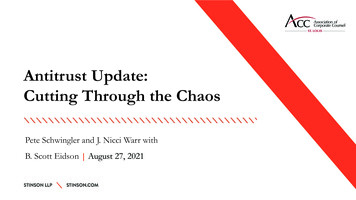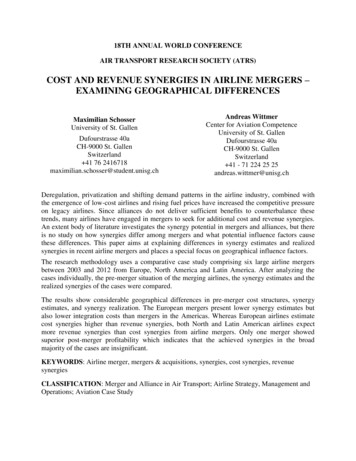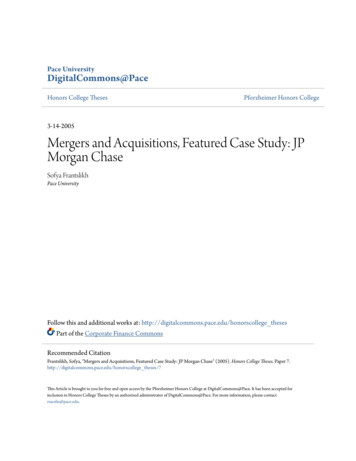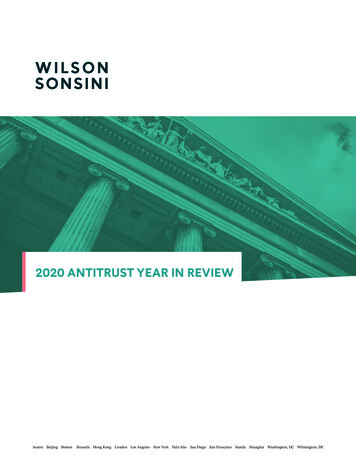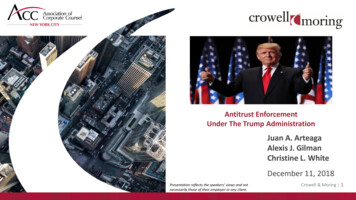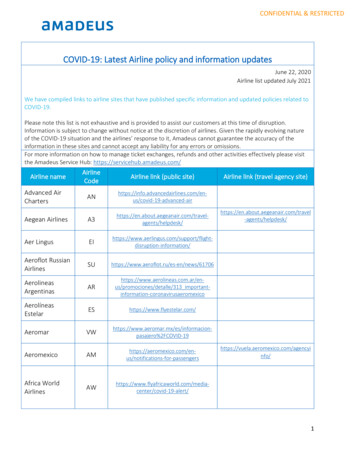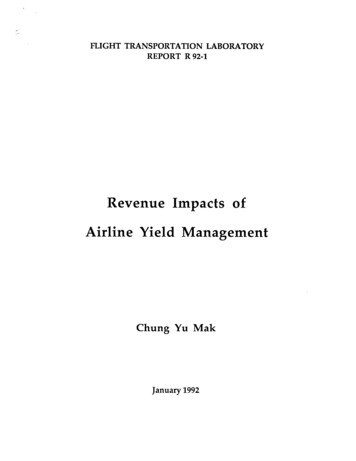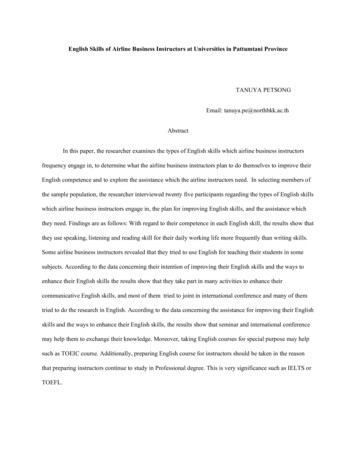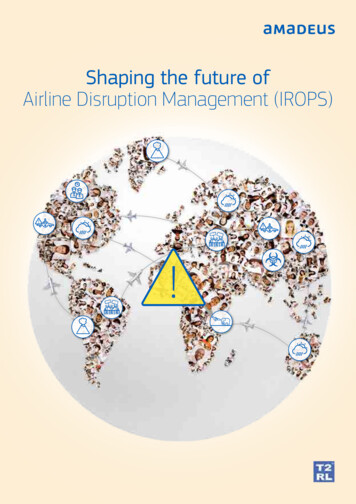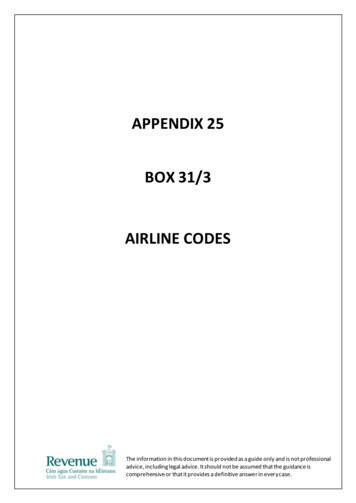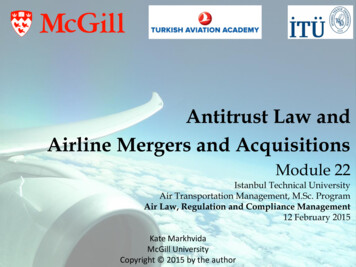
Transcription
Antitrust Law andAirline Mergers and AcquisitionsModule 22Istanbul Technical UniversityAir Transportation Management, M.Sc. ProgramAir Law, Regulation and Compliance Management12 February 2015Kate MarkhvidaMcGill UniversityCopyright 2015 by the author
Outline Trends in Airline MergersAntitrust Issues with Airline MergersMerger Control Laws and EnforcementThe American-US Airways Case Study
Trends in Airline Competition
Trends in airline competition To key trends since deregulation andliberalization– new business models (LCCs, ULCCs)– consolidation Airlines developed hybrid business models inresponse to competition– legacy carriers seek to improve their costs; low-costsubsidiaries– low-cost carriers diversify by offering value-addedservices
Trends in airline competition Increased and diversified forms of horizontalcooperation between airlines– alliances– mergers & acquisitions Airline cooperation deepens in depth andscope– metal-neutral joint ventures
Trends in airline M&ASource: Frost and Sullivan (2013)
Definition of a merger The acquisition by one airline of the control orownership of another airline. Airline mergers and acquisitions can be– Horizontal– Vertical ASAs distinguish between– Domestic mergers (carriers of the same nationality)– International mergers (carriers with differentnationalities)
Why do airlines merge? Financial distress post-deregulation– Internal factors (bad management)– External factors (economic downturns, fuel price,demand shocks, increased competition, etc.)– Competitive practices (state aid, tax free airports,low labour costs, etc.) Consolidation is subject to merger controlunder competition laws– Financial distress is considered by competitionauthorities in merger control
Major non-U.S. mergersAir Canada / Canadian Airlines (2001)Air France/KLM (2004)Japan Airlines / JAS (2006)Lufthansa / Swiss, Austrian Airlines,Brussels Airlines British Airways / Iberia (2011) LAN / TAM (2011)
Merger ControlLaws and Enforcement
Merger control laws Countries have merger control laws that applygenerally to all industries (not only to airline mergers)– US: The Sherman Act The Clayton Act Other statutes to close loopholes– EU: The Treaty on the Functioning of the European Union EC Merger Regulation and Implementing Regulation– Canada: The Competition Act Merger control laws are forward-looking andpreventive in nature
Pre-merger notification Approximately 100 states have pre-mergernotification laws– Requirements range from simple notification tointensive investigations– Jurisdictional thresholds are determined by thesize of the transaction Reviews by antitrust agencies may besuspensory, non-suspensory or hybrid– The principal objective is to determine if themerged airline will have market power toincrease prices
How do competition authoritiesreview airline mergers? Competition authorities are concerned withimpact on markets where competition islikely to be lowered post-merger– Identify overlapping markets– Assess the merged airline’s ability to exercisemarket power– Assess the anti-competitive effects that are likelyto result post-merger
Network overlap
Bad mergers may get approved Competition authorities may still approvea merger, even if it will likely lead to alessening of competition– The efficiency defense The merger will result in efficiencies or costreductions– The failing firm defense one of the merging airlines is likely to fail in theabsence of the merger
But with remedies Competition authorities may apply/seekremedies in the case of an anticompetitiveairline merger– Outright prohibition– Structural remedies Airport slot divestitures Route divestitures Gate divestitures– Behavioral remedies Access to FFPObligation to interlineCapacity of price constraintsAlliance membership withdrawal
More on remedies Remedies in merger control recognizethat mergers are the most integrated formof consolidation– A merger eliminates competition betweencarriers as airlines no longer make separatebusiness decisions post-merger
Airline Merger Controlin the United States
Historical Context Prior to 1985, airline mergers required approval bythe Civil Aeronautics Board– Approval meant antitrust immunity– CAB could apply remedies as a condition of approval Between 1985 and 1989, airline mergers wereregulated by the U.S. DOT– All 21 merger applications approved After 1989, airline mergers are reviewed by the U.S.DOJ under section 7 of the Clayton Act– U.S. DOT retained jurisdiction over internationalalliances
The Clayton Act The Clayton Act prohibits a person “engagedin commerce or in any activity affectingcommerce” from acquiring “the whole or anypart” of a business if the acquisition maysubstantially “lessen competition or tend tocreate a monopoly.”– To prevail, the plaintiff must define the relevantmarket and prove that the merger will create adanger of anticompetitive consequences.
The relevant market The relevant market is the geographic andproduct market, using reasonableinterchangeability or cross-elasticity ofdemand analysis.– Although market share and concentration levelsare relevant, they are not conclusive.– Instead, courts examine the market’s structure,history and future, the characteristics of thecustomers, trends toward concentration orconcentration, the existence of competitors andbarriers to entry.
The geographic market The relevant geographic market is an areawhere the dominant firm– can increase its price without large numbers ofconsumers turning to alternative supply sourcesoutside the area The relevant geographic market incommercial aviation is a city pair– Airport pairs– Hub airports– Networks
The product market The relevant product market requires anassessment of the products that aresufficiently close substitutes to competeeffectively in each other’s markets– Courts employ a “reasonable interchangeability”standard gauged by “(1) the product uses, i.e., whether the substituteproducts or services can perform the same function,and/or (2) consumer response (cross-elasticity); that is,consumer sensitivity to price levels at which they electsubstitutes for defendant’s product or services.”
The product market Scheduled passenger air transportation indefined city-pairs is probably the relevantproduct market in commercial aviation (thecompetitive alternatives of rail, bus andautomobile transport, or freight transportation,likely can be ignored for long-haul flights).– Non-stop versus connecting flights– Premium versus economy class– Business (time-sensitive) versus leisuretravellers (time-insensitive)– Low frills versus full service
The AA / US Airways Case Study
The world’s largest airline
The world’s largest airline
AA / US Airwaysinternational networks
AA / US Airwaysdomestic networks (East Coast)
The U.S. DOJ response to themerger The U.S. DOJ challenged the proposed 11 billionmerger on the grounds that– “[the merger] would substantially lessen competitionfor commercial air travel in local markets throughoutthe United States and result in passengers payinghigher airfares and receiving less service.” Main concerns– US Airways Advantage Fares– Higher ancillary fees– Facilitated coordination in domestic markets
Washington ReaganNational AirportUS Airways: 56% of slots at DCAAmerican-US Airways: 68% of slots at DCA
The airlines’ response“Blocking this procompetitive merger will denycustomers access to a broader airline network thatgives them more choices.Further, this merger provides the best outcome forAMR’s restructuring. The widespread supportfrom the employees and financial stakeholdersof both airlines underscores the fact that this isthe best path forward for both airlines and thecustomers and communities we serve.”
Settlement resolves concerns A settlement was reached to increasepresence of low cost carriers inproblematic markets and retain service tosmall communities– Slot divestiture 52 slot pairs at Washington’s Reagan National airport 17 slot pairs at New York’s LaGuardia airport– Gate divestiture 2 gates at each of Boston, Chicago, Dallas, LA and Miami– American is required to maintain service From its hubs to the states participating in the lawsuit
Trends in airline competition To key trends since deregulation and liberalization -new business models (LCCs, ULCCs) -consolidation Airlines developed hybrid business models in response to competition -legacy carriers seek to improve their costs; low-cost subsidiaries -low-cost carriers diversify by offering value-added services
